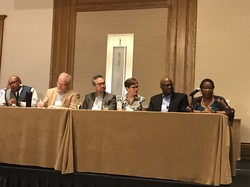Reflecting on the losses Los Ranchos Presbytery has experienced in the last five years – nine churches containing more than 10,000 members dismissed to other bodies and net loss of church property totaling $60 million -- Forest Claasen, co-executive recalls a story attributed to, but probably not told, by Desmond Tutu.
“The missionaries came to our land with the Bible and said, ‘let us pray,’” the story goes. “So we closed our eyes and prayed and when we opened them up they had the land and we had the Bible. And we got the better part of the deal.”
“It has been a work to find our way together,” Claasen said of his presbytery’s recent plight. “We’ve got long way to go but we’re figuring it out.”
That sentiment was echoed in remarks by a panel of a half-dozen mid council leaders here Tuesday (October 17) as the annual Mid Council Leaders Gathering drew to a close here.
Mark Hong, the executive/stated clerk for the Synod of Southern California and Hawaii – who noted that his synod is the largest in the denomination “because we include half of the Pacific Ocean” – said another presbytery in the synod lost 11 congregations “and is still reeling.” In such a situation, the role of leadership is one of mere presence. “The great work is just showing up,” Hong said, “being out there developing relationships to see what partnership in mission can do among seven presbyteries.”
Relationship building as the way to effective mission partnership is key in all mid councils, no matter their size and the size of their congregations.
Cindy Kohlmann, resource presbyter for the presbyteries of Boston and Northern New England, noted that the combined membership of those two presbyteries make them “smaller than some of the PC(USA)’s congregations. For us, 100 members is a big church, 50 members is medium-sized.”
A “resource presbyter” – Kohlmann’s title – is just that, she said. “It’s a new model of leadership to get resources to these congregations. There’s lots of abundance and our churches are beginning to realize utilize those resources. We have many more joys than challenges.”
On the other end of the statistical spectrum lies the Synod of Mid-Atlantic. “We have five of the 10 largest presbyteries in the PC(USA) and eight of the 20 largest,” said Warren Lesane, the synod’s executive and stated clerk. And yet, a restructuring of the Synod of Mid-Atlantic a decade ago “dried up racial ethnic ministries and leadership in the synod,” Lesane said.
With Charlotte, Baltimore and Charlottesville –sites of some of the most disturbing racial clashes of recent years in the U.S. – “we spend a lot of our time in our synod focused on issues of race and reconciliation.”
With a history of all-black mid councils – three presbyteries and one synod before Presbyterian reunion in 1983 – Lesane said the synod is exploring “whether we can be the body that recruits and trains the next generation of African American leaders for the denomination.”
The synod’s largest presbytery and the third largest in the PC(USA), Charlotte Presbytery, is facing radical transformation after its staff was reduced from 12 to three in 2012. “We have been engaged in discerning a future that is not staff-driven,” said Charlotte Presbytery’s stated clerk, Tamara Williams, “to build relationships and strengthen congregations as a presbytery, not as a staff.”
After extensive conversations – called “world cafes” – throughout the presbytery, Charlotte has created a Ministry Resource Committee “to be out in the presbytery answering the questions, ‘What is God doing and how can the presbytery resource that?’”
Small rural churches in the presbytery, particularly, “had felt disconnected,” Williams said. But Charlotte Presbyterians “are beginning to see encouraging partnering all across the presbytery,” she added. Partnering with local Methodist and Baptist congregations, one tiny rural church in the presbytery has produced in a community garden 60,000 pounds of food which has been donated to local agencies.
Giddings-Lovejoy Presbytery, which will host next summer’s 223rd General Assembly in St. Louis, has 16 “50/50 churches,” said Transitional Leader Craig Howard, referring to congregations with 50 or fewer members and a budget of less than $50,000. “Everyone doesn’t want to be large and wealthy,” Howard said. “They have learned how to live under water, in perpetual struggle for survival.”
One very small church in Giddings-Lovejoy hosts a homecoming weekend every year, with a celebratory worship Service on Sunday morning. “That little church,” Howard said, “collects an offering big enough at that service to fund the congregation’s ministry for the whole year.”

